Women's electric bike purchasing advice: how to choose the right product
- What You Need to Know
- With e-bikes, those interested can cover long distances in the city and in the countryside without exerting themselves too much – but sports enthusiasts also get their money’s worth.
- The most significant difference between women’s e-bikes and models for men is the frame construction.
- Some women’s e-bikes have a low entrance or exit, which can be very helpful for people who are less mobile.
- Users should inform themselves sufficiently about the legal framework of their chosen product.
- The manufacturer Giant has developed an e-bike brand that caters specifically to the needs of women.
Why women should use women’s e-bikes
Cycling is often one of the most popular leisure sports activities. But this form of transport also scores with numerous aspects in everyday life. Anyone who enjoys cycling or wants to keep fit should consider purchasing an e-bike. This can be recommended for both young and older ladies. It makes sense for interested females to look into the area of e-bikes that have been developed especially for women. A women’s electric bike has a slightly different frame geometry compared to e-bikes for men. While the differences are not immediately visible at first glance, some important details are immediately apparent upon closer inspection.
What are the advantages of women’s e-bikes?
In addition to being an environmentally friendly way of getting around, women’s e-bikes score points for being a gentle form of exercise that is also suitable for people with health problems. They are very popular with both athletic and less athletic people. This is because long distances can be covered without much effort. Some women’s e-bikes are characterised by their special shape, which makes it much easier to get on and off. Other products, on the other hand, focus on maximum sportiness and are used by female athletes who like to do sports.
Special features: Women’s e-bikes versus men’s e-bikes
The following special features or differences should be taken into account by interested female buyers during their research:
- The frame size is slightly smaller
- The tube lengths and angles are different
- The riding position is different, possibly more upright
However, which frame size and which frame shape fits best does not necessarily have to be the same for every potential female customer. It could happen, for example, that a unisex e-bike or a men’s e-bike fits a woman equally well or even better. However, more and more manufacturers are looking into whether and which e-bikes are best suited for women – and accordingly offer women’s products in their range.
Possible uses: city or trekking bike
Young and older women who want to be physically active or who want to cover longer distances by bike in everyday life can find out about women’s e-bikes here. The uses of these products are numerous: there is the possibility of riding an e-bike through the city as well as taking it on a sporty tour through nature. Depending on your physical condition, it can make sense to buy an e-bike as a second bike or to replace your normal bike completely. The latter is a good option for women of senior age who would like to switch to an electric bike because they like to cover long distances outdoors. Whether young or old, women’s e-bikes can make everyday life easier on the one hand and serve as fitness equipment on the other.
Some employers encourage purchase and use
Some employers promote the health aspect of e-bike use and subsidise the purchase of such a motor-assisted bike. Other employers provide e-bikes to employees for commuting or even for free use.
Different e-bike models
Before making a purchase decision, interested parties should inform themselves in detail about the different types in order to ultimately decide on the right product that fits their own needs exactly. First of all, the difference between e-bikes, pedelecs and S-pedelecs should be pointed out. Here, misunderstandings often arise regarding the designations.
What is the difference between pedelecs and e-bikes?
Pedelecs – the abbreviation stands for Pedal Electric Cycle – and e-bikes are often confused with each other. However, there is a serious difference that concerns the e-drive. If you ride an e-bike, you get assistance from the motor at the push of a button without actively pedalling yourself. It is important to know that these products are subject to registration from a speed of six kilometres per hour. For this reason, the market actually offers mostly pedelec bikes. The designations are therefore a little confusing. On the other hand, if you sit on a pedelec, you have to actively pedal to get the pedal assistance you want. Up to 25 kilometres per hour (hm/h), these products are still considered bicycles and therefore do not require registration. The rider can theoretically also switch off the motor completely. So: the absolute majority of e-bikes on offer are actually pedelecs.
What are the differences between pedelec and S-pedelec?
The S in S-pedelec stands for the word speed. The riding principle is the same as for the pedelec. As described above, riders can cycle up to 25 kilometres per hour on normal pedelecs. The S-products can do more: the e-drive of an S-pedelec supports up to a speed of 45 kilometres per hour. Accordingly, the drive is also equipped with higher power. For these speed e-bikes, however, users need an insurance licence plate and at least a moped driving licence. Helmets are also compulsory.
Later in this text you will learn more about insurance, registration and other requirements from the Road Traffic Act.
Mountain bike, trekking bike or city bike – different models
To give those interested in buying a detailed overview of the different models, you will find descriptions of the designs here. All e-bike types are also available as speed variants. Incidentally, the manufacturer GIANT has particularly focused on women’s e-bikes and promotes the Liv brand. These products fall into the categories of e-mountain bikes or trekking e-bikes. They also make off-road rides fun.
Well-known brands
Kalkhoff | Fischer | Bosch | KTM | GIANT | Liv
What is an e-mountain bike?
E-mountain bikes, also abbreviated to E-MTB, are becoming increasingly popular even among experienced female bikers. The prejudice that a tour on an e-mountain bike is less strenuous has long been dispelled. The only difference is that users with an e-drive can extend and expand their training. Instead of just two stony descents, for example, female riders can even manage four or five with this bike. Uphill rides can also be completed without major problems. Electric mountain bikes are therefore very much in vogue among sports enthusiasts – both women and men. They are characterised by the following criteria: precise steering, strong motor support, suspension fork, derailleur gears, hydraulic disc brakes, special frame suspension (full or hardtail) and suitable tyres.
City e-bike: All-rounder for everyday use
The city e-bike is particularly suitable for urban areas. As a pedelec variant, it offers a lot of comfort in everyday life, as it is comfortable on the one hand and covers long distances at a brisk pace on the other. Commuting to work is also fun with such a city bike. Compared to a mountain bike, the seating position is more like that on a Dutch bike. The so-called low riders without tubes make it particularly easy to get on, whereas the diamond frames with tubes focus more on sportiness.
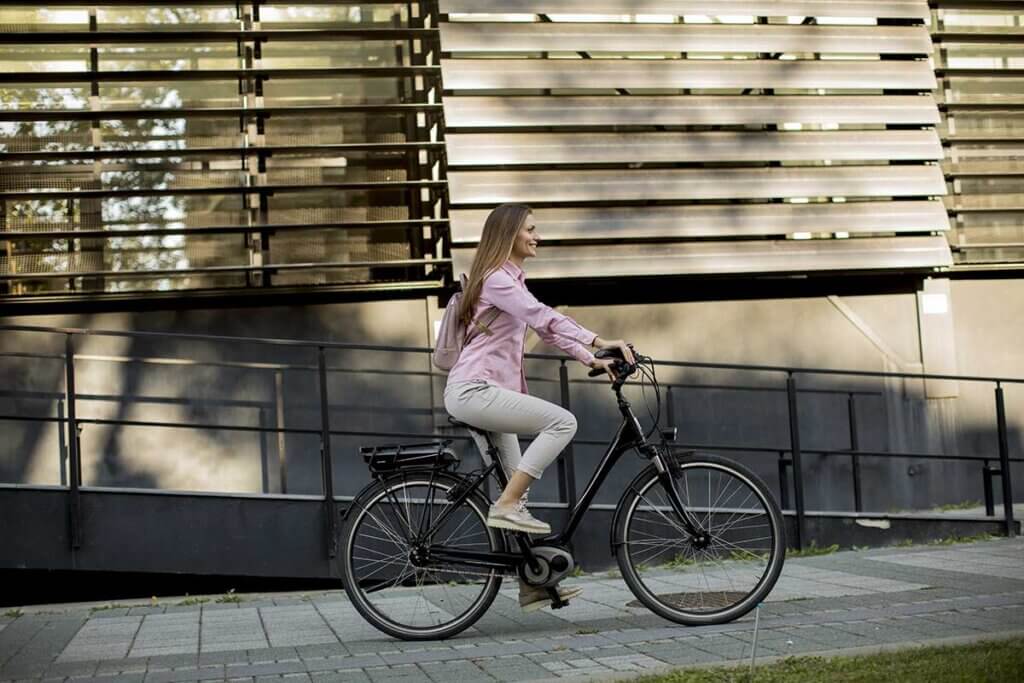
In this case, female users also adopt a flatter riding position. Low-entry bikes are particularly popular with women – and men too, by the way – who are less interested in speed and more in the comfort factor. Electric city bikes are characterised above all by their ergonomic design, riding comfort and equipment. This includes, for example, high-quality brakes or automatic gears.
Trekking e-bike: A bike for all purposes
This version of a pedelec combines the sportiness of an e-mountain bike and the comfort of a city e-bike. Thus, a trekking e-bike is considered a true all-rounder among women’s bikes. Users can not only cycle through the city in everyday life, but also undertake endurance tours in the countryside. It is suitable for all types of terrain and can also be used to carry panniers. Trekking e-bikes score with their stable construction. Ideally, they should have a powerful battery.
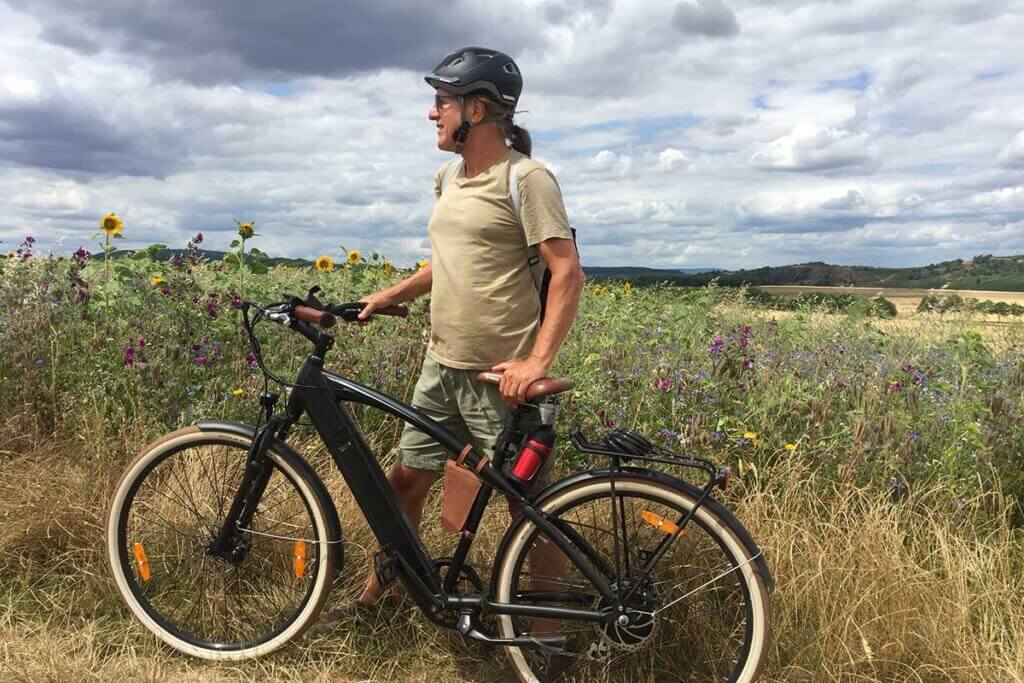
Hydraulic disc brakes and gears with at least nine speeds round off the profile of a trekking e-bike. Female riders who cannot decide between an e-mountain bike and an e-city bike should consider buying a trekking e-bike.
XXL e-bike: For more stability
These e-bikes are especially recommended for those who have a higher body weight. XXL e-bikes make the riding experience for this group very comfortable and safe, as the bike scores with particular stability. However, it is not only your own weight that can be decisive for choosing this product. Do you often transport heavy loads or a child seat? Then an XXL e-bike could also be right for you. There is no visual difference to other pedelecs. Only the stable construction of the frame makes this bike a reliable load carrier.
Compact e-bike: The practical travel companion
Also called folding e-bikes, these e-bikes offer very practical handling. This is especially useful in town when shopping or travelling, because compact e-bikes can be folded to a compact size thanks to a folding mechanism. Sportiness is less of a focus here. Comfort, on the other hand, is a priority, as with city e-bikes. Folding e-bikes are popular with female riders because they are so easy to stow away – even on the train -, because they are pleasantly manoeuvrable without seeming unstable, because they are ideal for taking along on journeys and because everyone can ride them – young or old, small or large.
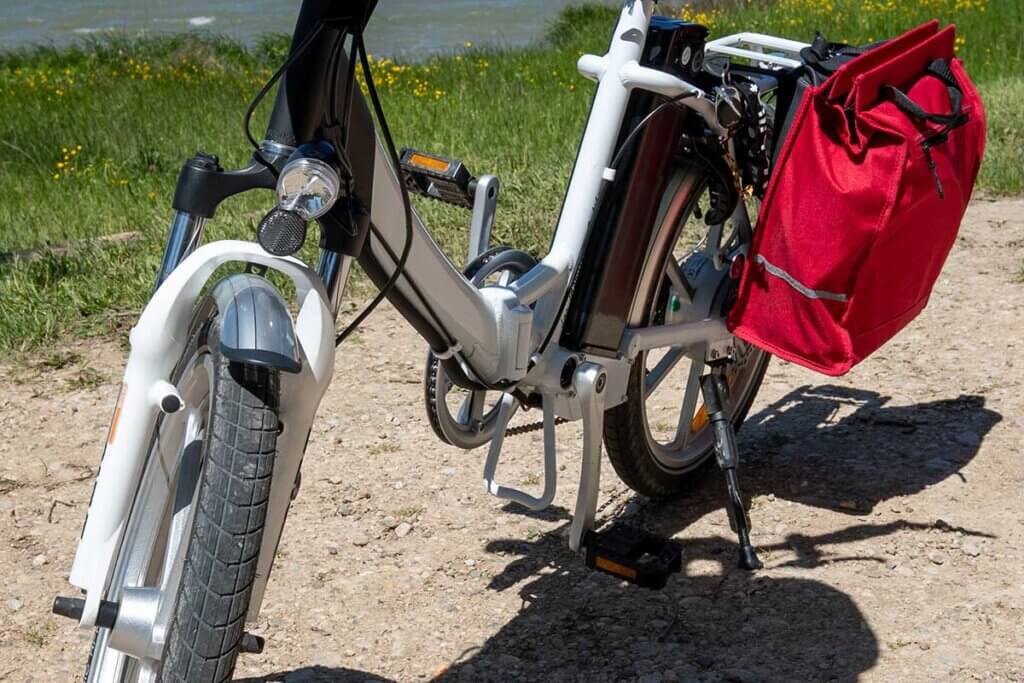
Buying criteria at a glance
Women interested in buying an e-bike should test ride it before making a decision to be sure they are choosing the right product. In general, size and bike type are among the most important points. First think about what you want to use the bike for: for the city, for travelling, for commuting or for trekking and cycling tours?
Load capacity, dimensions and weight
The wheel and frame size is always given in inches per centimetre (inch/cm). A 28-inch bike is suitable for taller women, a 26-incher fits smaller people better. Frame dimensions range from 44 to 50 centimetres, depending on the model. Riders should also compare the maximum permitted total weight of the e-bike with their own body weight and any additional loads for the bike.
Rule of thumb for calculating the load capacity of the e-bike:
Body weight + loads (child seats with children, shopping) < permissible total weight?
The tare weight of an e-bike is considerable: the bikes sometimes weigh 25 to almost 30 kilograms.
Carbon frames are much lighter
Users who can foresee that they will be carrying the e-bike over a tree trunk or up steps should look for a carbon frame. However, the high-quality material is reflected in a higher purchase price.
Power: Three different motor types
The motor support depends largely on where the electric motor is located on the e-bike. The majority of the high-quality electric motors used come from the Bosch company.
Rear motors are installed in the hub of the rear wheel and score points with their powerful performance: they can partially recharge the battery through heat recovery during braking (recuperation) and thus save energy, have a very low operating noise and work very gently on materials. The only disadvantage is the high, pushing weight when riding off-road, as the weight accumulates in the rear part of the e-bike. This type of construction is often used due to the expected cost savings compared to a mid-mounted motor. This type is often found on sporty e-bike variants.
With a centrally mounted motor, the shift in the centre of gravity is optimal: the low, well-distributed weight results in a very good riding experience with direct power transmission at the same time. In contrast to the other two motor arrangements, e-bikes with mid-mounted motors, also known as bottom bracket motors, also have the option of coaster pedalling. The disadvantages of this design are limited: The higher load on the chain and sprocket as well as a higher purchase price compared to the other designs should be mentioned.
Another option for installing a hub motor is to drive it via the front wheel. Although this variant reduces the purchase price and is therefore more likely to be found in affordable e-bike models, it also has disadvantages: for example, steering is more difficult because the motor on the front wheel must always be moved. In the worst case, even swerving is possible. For this reason, the front-wheel motor is being used less and less.
Only up to 250 watts of power are exempt from registration plates
Regardless of which drive is installed: When deciding on a purchase, you should make sure that the motor does not produce more than 250 watts of power: Otherwise, the e-bike would require an insurance licence plate.
Gear system and number of gears
Here riders can find out more about hub and derailleur gears and which types are better suited for which purpose:
Hub gears
- Low maintenance
- Suitable for city and normal cycling tours
- 7-speed gears are sufficient
Derailleur gears
- Cleaning and maintenance necessary
- Suitable for mountains and sporty bike tours
- 10-speed gears recommended
- Fast, precise shifting
Material and workmanship: brakes
Depending on the brake model, women’s e-bikes have rim or disc brakes. Disc brakes are preferable to rim brakes because they usually have more braking power. Hydraulic systems are more effective because they brake with the help of two pistons on both sides. Good braking is important in all situations, but riders should use the highest quality brakes, especially for downhill mountain riding. Also bear in mind that you are usually faster on a women’s e-bike than on a normal bike.
Battery
The battery capacity is always given in watt-hours (Wh). The longer the battery lasts, the higher the possible range of the e-bike. The respective running and charging time depends on the quality of the battery. 500 watt-hours are standard. If you are not using the e-bike, it is best to remove the battery and store it in a dry place. LC displays are available to show the battery status at all times. If the battery is almost empty, it is high time to charge it. Do not let it become completely empty: this will have a negative effect on its longevity.
Most manufacturers do not offer batteries for self-exchange. However, replacement batteries are available for some models, but these must then be installed in a bicycle workshop. The batteries can be installed on the frame, in the frame itself or in the form of a luggage carrier.
Range
Depending on the battery capacity, women’s e-bikes can reach between 50 and 100 kilometres, according to the manufacturer’s specifications. The range thus refers to the number of kilometres that a single battery charge can last. It also depends on external circumstances such as weather conditions, weight, ground conditions and above all the selected level of support. A realistic value is obtained if you assume mixed conditions and set yourself to 50 percent of the maximum range stated by the manufacturer. You should therefore always start a longer day trip with a fully charged battery. Then even rides with a lot of headwind are no longer a problem.
How much do women’s e-bikes cost?
Inexpensive women’s e-bikes start at around 700 euros. Depending on the model, the higher-priced products usually cost more than 1,000 euros. However, these also have better battery capacities and gears with many gears. Of course, the range is then also considerably higher. In the premium segment, interested parties can expect prices between 3,000 and 4,000 euros, depending on the model.
Other noteworthy features
Frames made of aluminium are heavier than frames made of carbon material, so female e-bikers should consider spending more money to own a lighter, easier-to-handle women’s e-bike. Frame shape and size are crucial for comfort, as mentioned above. There are e-bikes with a top tube or those with a low entry and exit. A starting aid can be of particular interest if female riders want motor assistance when starting. The electric motor ensures easy starting and assists up to 6 kilometres per hour, which can be very helpful when starting uphill.
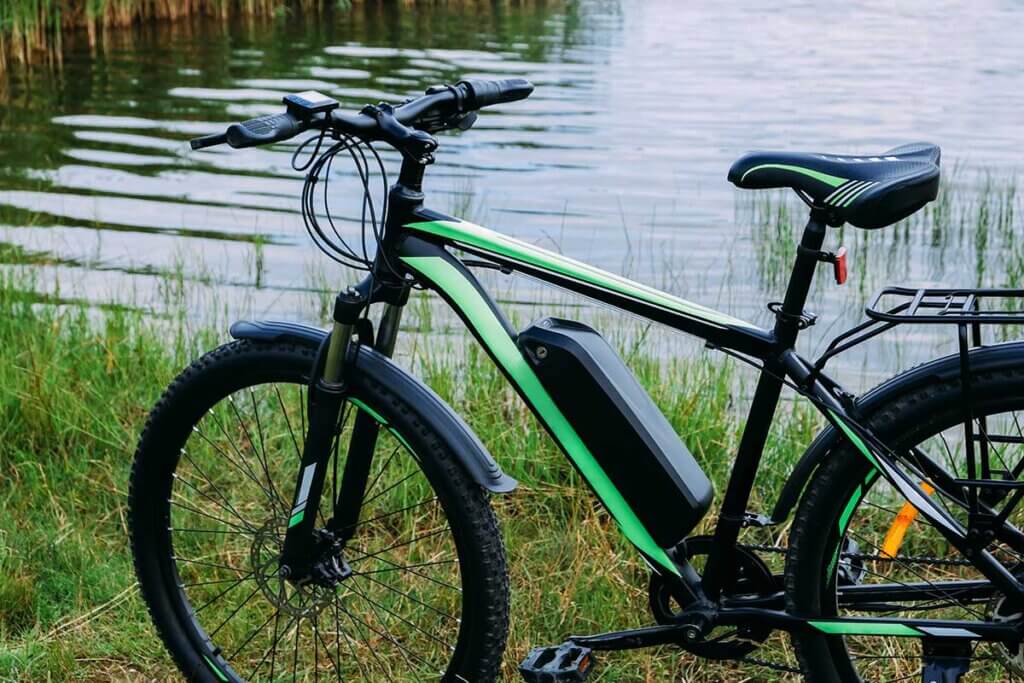
For safety, the following features are highly recommended. As a rule, women’s e-bikes offer most of these as part of the package, although some can be purchased by riders as an afterthought:
- Mudguards
- Lighting system
- Luggage rack
- Rear view mirror
- Reflectors
- LC display to show speed and total distance travelled.
Lights and reflectors are indispensable and should be fitted to every women’s e-bike. A luggage rack and mudguards, on the other hand, are not absolutely necessary and make the bike unnecessarily heavy if, for example, e-bikers are planning a sporty tour in the mountains. For shopping in the city, on the other hand, a stable luggage rack makes sense. If the e-bike has a bike computer, riders can use navigation functions on a display or check the battery charge level. Some e-bikes also offer the option of linking the integrated bike computer with a smartphone app.
These are the legal requirements for e-bikes and pedelecs
Does my e-bike need a licence plate or insurance? These are questions that interested people rightly ask themselves before buying an e-bike, because there are some points that you should definitely pay attention to.
At this point it is important to pay close attention to the differences between pedelecs and e-bikes. Therefore, in the following we will also talk about pedelecs and e-bikes with their specific identification features. According to the Road Traffic Act (StVZO), these specifications apply:
Pedelec with a maximum speed of 25 km/h
A pedelec of this type is considered a bicycle.
- The motor may have a maximum power of 250 watts and only provides assistance while pedalling.
- A starting aid of up to 6 km/h may be integrated.
- There is no age limit and no registration, driving licence or insurance plates are required.
- Helmets are not compulsory.
- Private liability insurance is recommended.
- Normal cycle paths can and should be used, if any are available.
- Trailers and child seats are allowed.
- When buying in the EU, look for the EU Declaration of Conformity. Ask the dealer about this.
S-pedelecs with a maximum speed of 45 km/h
Such an S-pedelec is considered a moped. The way it works is no different from that of pedelecs. The only difference is that the assistance does not only work up to a speed of 25, but up to 45 kilometres per hour.
- The motor has a maximum output of 4,000 watts.
- There is an age restriction of at least 16 years.
- Operating licence, individual registration, third-party insurance and insurance plates are compulsory.
- Class AM driving licence (scooter driving licence) is required.
- Wearing a safety helmet is compulsory. Bicycle helmets are permitted.
- S-pedelecs are not allowed to ride on normal cycle paths. One-way streets are also taboo.
- Trailers are not allowed, but child seats are.
E-bike with a maximum speed of 20 km/h = light moped, electric moped
The e-bike is considered a light moped, also called an electric moped.
- The maximum power of the motor is 500 watts.
- The motor assists without riders pedalling.
- A minimum age of 15 years is required, as well as a moped test certificate and insurance licence plate.
- However, helmets are not compulsory.
- Cycle paths may be used in part if they are marked accordingly.
- Trailers are not allowed, but child seats are.
E-bike with a maximum speed of 25 km/h = moped
These e-bikes are considered mopeds.
- The way it works is the same as for the e-bike with a maximum speed of 20 km/h.
- The minimum age is 15 years.
- Helmets are compulsory.
- Moped test certificate and insurance number plate are required.
- Cycle paths may be used in part if they are marked accordingly.
- Trailers are not allowed, but child seats are.
E-bike with a maximum speed of 45 km/h = moped
This vehicle is a moped.
- It functions like an e-bike with a maximum speed of 20 km/h. The minimum age is 16.
- The minimum age is 16 years.
- Helmets are compulsory.
- Driving licence class AM and insurance plates are required.
- Use of cycle paths is not permitted.
- Child seats are permitted.

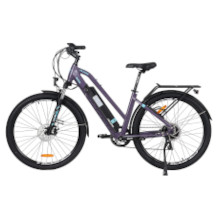
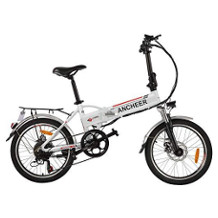
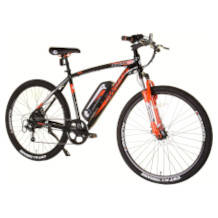
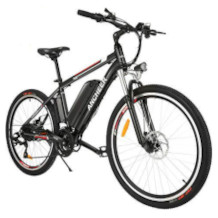


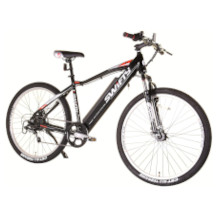
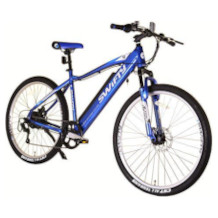

 153 reviews
153 reviews